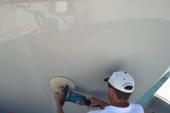Spring brings the promise of a new boating season; it is an exciting time of year to be a boater.
If this warmer weather wasn’t evidence enough then you might want to take a look at the your local marina's webcam! Marinas and boat yards are a hive of activity in the spring, and a busy time for anyone who works in the marine industry!
If you are anything like most boating families, you are eagerly waiting for summer to get here. Since your cruiser or runabout has been securely sleeping all winter long, it’s time to make sure your boat is ready to shine and is well protected this summer. Since the boats are already out of the water this is the perfect time to wash off the winter dirt buildup. Let's talk about what it takes to get that done well and quickly; we don't want to cut into your precious boating season!

- Start with Water. This sounds simple enough, and is often over looked. The more running water from buckets or a hose the better. Winter means dust and dirt. The more water you have the better lubricated and softer the dirt will be as it is being washed off. Pressure washers speed up the job, and are handy but are not mandatory.
- Be a "top down" worker. Always work from the very top of your boat and wash everything down and off the boat. Wash the entire boat before even thinking wax.
- Be Gentle. Use mild biodegradable soap, a soft brush for the shiny gelcoat, and a harder bristle for the non-skid areas. Shurhold Marine has a great line of products for this part of the job.
- The right tool for the job. This is key for the next part. A variable speed, orbital polisher is a must have. Not only does it save you time, and energy, it also can help you achieve superior results.
- Get buffing. Use a mild compound, or restorer to bring the shine back from dull/lightly oxidized gelcoat. If it is heavily faded, you may want to talk to your marina about what is called "wet sand and polish". If you don't need compound, a "One Step" cleaner/wax may do the trick. If your boat is only one or two years old, and very clean, you may be able to skip straight to polish and wax at this point. Get advice on what products to use from your local marina or a boater you trust.We find the Meguiars Marine or 3M line of products to be excellent. Make sure the wax has completely dried to a haze before you try to remove it.
- Repeat. Do your waxing the same way you washed...from the top down. Once you have polished the gelcoat to a shine, and coated it with a UV resistant Wax/Sealer, it is time to get out a terry cloth, and hand buff it to a gleaming shine. you also want to make sure all the wax is removed, and the dust blown off.
- The last step. Clean the windows, clear vinyl, and wash and treat the upholstery in the cockpit. It should be noted that product selection is KEY for this as harsh chemicals may remove more than the dirt. Marine fabrics are manufactured with bio-cides and UV inhibitors that protect the fabrics. Use caution when applying any product and if you don't know, ask a professional.
 Waxing a boat takes a combination of hard work, the right equipment, and is something that can be handled by a boat owner if you have the time and energy to put into it. If either are in short supply, a great marina will have a program in place and a trained team like ours. Here at Len's Cove we have seasoned staff that can do the work for you using the right equipment to make sure the job is done right, and just in time for launch. Take a look at what the program should look like here.
Waxing a boat takes a combination of hard work, the right equipment, and is something that can be handled by a boat owner if you have the time and energy to put into it. If either are in short supply, a great marina will have a program in place and a trained team like ours. Here at Len's Cove we have seasoned staff that can do the work for you using the right equipment to make sure the job is done right, and just in time for launch. Take a look at what the program should look like here.
Wax will not only protect your boat and keep that wash from disappearing but it will also keep the gelcoat on your boat looking new. If you have an older or used boat it can make it look new again! It is amazing seeing boats be brought back to life with a good wash and wax job. Whether you prepping your boat for the season, or getting ready to sell a boat, make it shine!
Eric Dunthorne and Sean Horsfall


